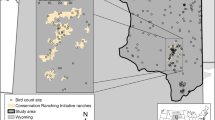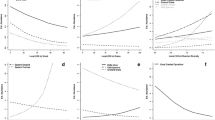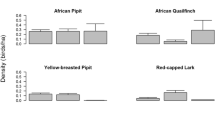Abstract
Context
Beyond the recognized importance of protecting large areas of contiguous habitat, conservation efforts for many species are complicated by the fact that patch suitability may also be affected by characteristics of the landscape within which the patch is located. Currently, little is known about the spatial scales at which species respond to different aspects of the landscape surrounding an occupied patch.
Objectives
Using grassland bird point count data, we describe an approach to evaluating scale-specific effects of landscape composition on patch occupancy.
Methods
We used data from 793 point count surveys conducted in idle and grazed grasslands across Wisconsin, USA from 2012 to 2014 to evaluate scale-dependencies in the response of grassland birds to landscape composition. Patch occupancy models were used to evaluate the relationship between occupancy and landscape composition at scales from 100 to 3000 m.
Results
Bobolink (Dolichonyx oryzivorus) exhibited a pattern indicating selection for grassland habitats in the surrounding landscape at all spatial scales while selecting against other habitats. Eastern Meadowlark (Sturnella magna) displayed evidence of scale sensitivity for all habitat types. Grasshopper Sparrow (Ammodramus savannarum) showed a strong positive response to pasture and idle grass at all scales and negatively to cropland at large scales. Unlike other species, patch occupancy by Henslow’s Sparrow (A. henslowii) was primarily influenced by patch area.
Conclusions
Our results suggest that both working grasslands (pasture) and idle conservation grasslands can play an important role in grassland bird conservation but also highlight the importance of considering species-specific patch and landscape characteristics for effective conservation.





Similar content being viewed by others
References
Bakker VJ, Baum JK, Brodie JF, Salomon AK, Dickson BG, Gibbs HK, Jensen OP, McIntyre PB (2010) The changing landscape of conservation science funding in the United States. Conserv Lett 3:435–444
Balmford A, Green RE, Jenkins M (2003) Measuring the changing state of nature. Trends Ecol Evol 18:326–330
Barnagaud J-Y, Barbaro L, Papaïx J, Deconchat M, Brockerhoff EG (2014) Habitat filtering by landscape and local forest composition in native and exotic New Zealand birds. Ecology 95:78–87
Bender DJ, Contreras TA, Fahrig L (1998) Habitat loss and population decline: a meta-analysis of the patch size effect. Ecology 79:517
Betts MG, Fahrig L, Hadley AS, Halstead KE, Bowman J, Robinson WD, Wiens JA, Lindenmayer DB (2014) A species-centered approach for uncovering generalities in organism responses to habitat loss and fragmentation. Ecography (Cop) 37:517–527
Betts MG, Forbes GJ, Diamond AW (2007) Thresholds in songbird occurrence in relation to landscape structure. Conserv Biol 21:1046–1058
Blevins E, With KA (2011) Landscape context matters: local habitat and landscape effects on the abundance and patch occupancy of collared lizards in managed grasslands. Landscape Ecol 26:837–850
Broms KM, Johnson DS, Altwegg R, Conquest LL (2014) Spatial occupancy models applied to atlas data show Southern Ground Hornbills strongly depend on protected areas. Ecol Appl 24:363–374
Burnham K, Anderson DR (2002) Model selection and multimodel inference: a practical information-theoretic approach, 2nd edn. Springer, New York
Buxton VL, Benson TJ (2015) Do natural areas in urban landscapes support successful reproduction by a group of conservation priority birds? Anim Conserv 18:471–479
Cade BS (2015) Model averaging and muddled multimodel inferences. Ecology 96:2370–2382
Chandler RB, King DI, Raudales R, Trubey R, Chandler C, Arce Chávez VJ (2013) A small-scale land-sparing approach to conserving biological diversity in tropical agricultural landscapes. Conserv Biol 27:785–795
Chen J, Zhu X, Vogelmann JE, Gao F, Jin S (2011) A simple and effective method for filling gaps in Landsat ETM+ SLC-off images. Remote Sens Environ 115:1053–1064
Clavero M, García-Berthou E (2005) Invasive species are a leading cause of animal extinctions. Trends Ecol Evol 20:110
Clavero M, Brotons L, Pons P, Sol D (2009) Prominent role of invasive species in avian biodiversity loss. Biol Conserv 142:2043–2049
Curtis JT (1959) The vegetation of Wisconsin: an ordination of plant communities. University of Wisconsin, Madison
Davis S, Brigham R, Shaffer T, James P (2006) Mixed-grass prairie passerines exhibit weak and variable responses to patch size. Auk 123:807–821
de Lima RF, Dallimer M, Atkinson PW, Barlow J (2013) Biodiversity and land-use change: understanding the complex responses of an endemic-rich bird assemblage. Divers Distrib 19:411–422
Desrochers A, Renaud C, Hochachka WM, Cadman M (2010) Area-sensitivity by forest songbirds: theoretical and practical implications of scale-dependency. Ecography (Cop) 33:921–931
Donald PF, Green RE, Heath MF (2001) Agricultural intensification and the collapse of Europe’s farmland bird populations. Proc Biol Sci 268:25–29
Drum RG, Ribic CA, Koch K, Lonsdorf E, Grant E, Ahlering M, Barnhill L, Dailey T, Lor S, Mueller C, Pavlacky DC Jr (2015) Strategic grassland bird conservation throughout the annual cycle: linking policy alternatives, landowner decisions, and biological population outcomes. PLoS ONE 10:e0142525
Dymond CC, Mladenoff DJ, Radeloff VC (2002) Phenological differences in Tasseled Cap indices improve deciduous forest classification. Remote Sens Environ 80:460–472
Ehrenfeld J (2000) Defining the limits of restoration: the need for realistic goals. Restor Ecol 8:2–9
Fiske I, Chandler R (2011) unmarked: an R package for fitting hierarchical models of wildlife occurrence and abundance. J Stat Softw 43(1):23
Fitzgerald RW, Lees BG (1994) Assessing the classification accuracy of multisource remote sensing data. Remote Sens Environ 47:362–368
Foley JA, Defries R, Asner GP, Barford C, Bonan G, Carpenter SR, Chapin FS, Coe MT, Daily GC, Gibbs HK, Helkowski JH (2005) Global consequences of land use. Science 309:570–574
Foody GM (2002) Status of land cover classification accuracy assessment. Remote Sens Environ 80:185–201
Gazol A, Tamme R, Takkis K, Kasari L, Saar L, Helm A, Pärtel M (2012) Landscape- and small-scale determinants of grassland species diversity: direct and indirect influences. Ecography (Cop) 35:944–951
Gilbert MM, Chalfoun AD (2011) Energy development affects populations of sagebrush songbirds in Wyoming. J Wildl Manag 75:816–824
Green RE, Cornell SJ, Scharlemann JPW, Balmford A (2005) Farming and the fate of wild nature. Science 307:550–555
Grinnell J (1917) The niche-relationships of the California Thrasher. Auk 34:427–433
Halls L, Crawford H (1960) Deer-forest habitat relationships in north Arkansas. J Wildl Manag 24:387–395
Hammond TO, Verbyla DL (1996) Optimistic bias in classification accuracy assessment. Int J Remote Sens 17:1261–1266
Helzer CJ, Jelinski DE (1999) The relative importance of patch area and perimeter-area ratio to grassland breeding birds. Ecol Appl 9:1448–1458
Herkert J (1994) The effects of habitat fragmentation on midwestern grassland bird communities. Ecol Appl 4:461–471
Herkert J (1995) An analysis of midwestern breeding bird population trends: 1966-1993. Am Midl Nat 134:41–50
Herkert J, Reinking D, Wiedenfeld D, Winter M, Zimmerman JL, Jensen WE, Finck EJ, Koford RR, Wolfe DH, Sherrod SK, Jenkins MA (2003) Effects of prairie fragmentation on the nest success of breeding birds in the midcontinental United States. Conserv Biol 17:587–594
Hron K, Filzmoser P, Thompson K (2012) Linear regression with compositional explanatory variables. J Appl Stat 39:1115–1128
Hutchinson RA, Valente JJ, Emerson SC, Betts MG, Dietterich TG (2015) Penalized likelihood methods improve parameter estimates in occupancy models. Methods Ecol Evol. doi:10.1111/2041-210X.12368
Jackson ND, Fahrig L (2014) Landscape context affects genetic diversity at a much larger spatial extent than population abundance. Ecology 95:871–881
Jacobs R, Thompson F, Koford R, La Sorte FA, Woodward HD, Fitzgerald JA (2012) Habitat and landscape effects on abundance of Missouri’s grassland birds. J Wildl Manag 76:372–381
Jaster LA, Jensen WE, Lanyon WE (2012) Eastern Meadowlark (Sturnella magna). Birds North Am (online)
Johnson D, Igl L (2001) Area requirements of grassland birds: a regional perspective. Auk 118:24–34
Johnson RR, Granfors DA, Niemuth ND, Estey ME, Reynolds RE (2010) Delineating grassland bird conservation areas in the U.S. Prairie Pothole Region. J Fish Wildl Manag 1:38–42
Jones NF, Pejchar L (2013) Comparing the ecological impacts of wind and oil & gas development: a landscape scale assessment. PLoS ONE 8:e81391
Kalnay E, Cai M (2003) Impact of urbanization and land-use change on climate. Nature 423:528–532
Kerr JT, Deguise I (2004) Habitat loss and the limits to endangered species recovery. Ecol Lett 7:1163–1169
Kéry M, Schmidt BR (2008) Imperfect detection and its consequences for monitoring for conservation. Community Ecol 9:207–216
Knorn J, Rabe A, Radeloff VC, Kuemmerle T, Kozak J, Hostert P (2009) Land cover mapping of large areas using chain classification of neighboring Landsat satellite images. Remote Sens Environ 113:957–964
Kormann U, Rösch V, Batáry P, Tscharntke T, Orci KM, Samu F, Scherber C (2015) Local and landscape management drive trait-mediated biodiversity of nine taxa on small grassland fragments. Divers Distrib. doi:10.1111/ddi.12324
Landis JR, Koch GG (1977) The measurement of observer agreement for categorical data. Biometrics 33:159–174
Lindenmayer D, Cunningham RB, MacGregor C, Crane M, Michael D, Fischer J, Montague-Drake R, Felton A, Manning A (2008) Temporal changes in vertebrates during landscape transformation: a large-scale “natural experiment”. Ecol Monogr 78:567–590
Losey J, Vaughan M (2006) The economic value of ecological services provided by insects. BioScience 56:311–323
MacKenzie D, Nichols J, Lachman G (2002) Estimating site occupancy rates when detection probabilities are less than one. Ecology 83:2248–2255
MacKenzie D, Nichols J, Hines J, Knutson MG, Franklin AB (2003) Estimating site occupancy, colonization, and local extinction when a species is detected imperfectly. Ecology 84:2200–2207
Margules CR, Pressey RL (2000) Systematic conservation planning. Nature 405:243–253
Martinuzzi S, Radeloff V, Higgins J (2013) Key areas for conserving United States’ biodiversity likely threatened by future land use change. Ecosphere 4:art58
Meanley B, Neff JA (1953) Food habits of the Bobolink in Arkansas rice fields. Auk 70:211–212
Murphy M (2003) Avian population trends within the evolving agricultural landscape of eastern and central United States. Auk 120:20–34
Nakazawa Y, Peterson A, Martinez-Meyer E, Navarro-Sigüenza AG (2004) Seasonal niches of Nearctic-Neotropical migratory birds: implications for the evolution of migration. Auk 121:610–618
Orians GH, Wittenberger JF (1991) Spatial and temporal scales in habitat selection. Am Nat 137:S29–S49
Parmesan C (2006) Ecological and evolutionary responses to recent climate change. Annu Rev Ecol Evol Syst 37:637–669
Phalan B, Onial M, Balmford A, Green RE (2011) Reconciling food production and biodiversity conservation: land sharing and land sparing compared. Science 333:1289–1291
Phelps W (1948) The discovery of the habitat of Gould’s hummingbird, Hylonympha macrocerca. Auk 65:62–66
Prugh LR, Hodges KE, Sinclair ARE, Brashares JS (2008) Effect of habitat area and isolation on fragmented animal populations. Proc Natl Acad Sci USA 105:20770–20775
R Development Core Team (2012) R: a language and environment for statistical computing. The R Foundation for Statistical Computing, Vienna
Rands MRW, Adams WM, Bennun L, Butchart SH, Clements A, Coomes D, Entwistle A, Hodge I, Kapos V, Scharlemann JP, Sutherland WJ (2010) Biodiversity conservation: challenges beyond 2010. Science 329:1298–1303
Reimer A (2013) Trends in U.S. Agricultural Conservation Programs
Reino L, Beja P, Osborne PE, Morgado R, Fabião A, Rotenberry JT (2009) Distance to edges, edge contrast and landscape fragmentation: interactions affecting farmland birds around forest plantations. Biol Conserv 142:824–838
Renfrew RB, Kim D, Perlut N, Smith J, Fox J, Marra PP (2013) Phenological matching across hemispheres in a long-distance migratory bird. Divers Distrib 19:1008–1019
Renfrew RB, Ribic CA (2008) Multi-scale models of grassland passerine abundance in a fragmented system in Wisconsin. Landscape Ecol 23:181–193
Renfrew RB, Saavedra AM (2007) Ecology and conservation of Bobolinks (Dolichonyx oryzivorus) in rice production regions of Bolivia. Ornitol Neotrop 18:61–73
Ribic CA, Guzy MJ, Sample DW (2009a) Grassland bird use of remnant prairie and conservation reserve program fields in an agricultural landscape in Wisconsin. Am Midl Nat 161:110–122
Ribic CA, Koford RR, Herkert JR, Johnson DH, Niemuth ND, Naugle DE, Bakker KK, Sample DW, Renfrew RB (2009b) Area sensitivity in North American grassland birds: patterns and processes. Auk 126:233–244
Robbins CS, Dawson D, Dowell B (1989) Habitat area requirements of breeding forest birds in the middle Atlantic states. Wildl Monogr 103:3–34
Rota CT, Fletcher RJ, Evans JM, Hutto RL (2011) Does accounting for imperfect detection improve species distribution models? Ecography (Cop) 34:659–670
Saab VA, Petit DR (1992) Impact of pasture development on winter bird communities in Belize, Central America. Condor 94:66–71
Sample D, Mossman M (1997) Managing habitat for grassland birds: a guide for Wisconsin. Department of Natural Resources, Bureau of Integrated Science Services, Madison
Sample DW, Ribic CA, Renfrew RB (2003) Linking landscape management with the conservation of grassland birds in Wisconsin. In: Bissonette JA, Storch I (eds) Landscape ecology and resource management: linking theory with practice. Island Press, Washington, DC, pp 359–385
Sanderson E, Redford K, Vedder A, Coppolillo PB, Ward SE (2002) A conceptual model for conservation planning based on landscape species requirements. Landsc Urban Plan 58:41–56
Sauer J, Hines JE, Fallon JE, Pardieck KL, Ziolkowski DJJ, Link WA (2014) The North American breeding bird survey, results and analysis 1966-2012. http://www.mbr-pwrc.usgs.gov/bbs/bbs2012.html. Accessed 21 Oct 2016
Sauer J, Link W (2011) Analysis of the North American breeding bird survey using hierarchical models. Auk 128:87–98
Spooner C, Yeager L (1942) Potential wildlife habitat on the Illinois prairie and some problems of restoration. J Wildl Manag 6:44–54
Stevens DL Jr, Olsen AR (2004) Spatially-balanced sampling of natural resources. J Am Stat Assoc 99:262–277
Tscharntke T, Clough Y, Wanger TC, Jackson L, Motzke I, Perfecto I, Vandermeer J, Whitbread A (2012) Global food security, biodiversity conservation and the future of agricultural intensification. Biol Conserv 151:53–59
Turker M, Arikan M (2005) Sequential masking classification of multi-temporal Landsat7 ETM+ images for field-based crop mapping in Karacabey, Turkey. Int J Remote Sens 26:3813–3830
USDA (2013) NAIP 2013 survey: summary report. Salt Lake City, Utah. http://www.fsa.usda.gov/Internet/FSA_File/2013_naip_survey_summary.pdf. Accessed 21 Oct 2016
Veldman JW, Overbeck GE, Negreiros D, Mahy G, Le Stradic S, Fernandes GW, Durigan G, Buisson E, Putz FE, Bond WJ (2015) Where tree planting and forest expansion are bad for biodiversity and ecosystem services. BioScience 65:1011–1018
Walther G, Post E, Convey P, Menzel A (2002) Ecological responses to recent climate change. Nature 416:389–395
Wiens JA (1969) An approach to the study of ecological relationships among grassland birds. Ornithol Monogr 8:1–93
Wilcove D, Rothstein D, Dubow J, Phillips A, Losos E (1998) Quantifying threats to imperiled species in the United States. BioScience 48:607–615
Winter M, Johnson DH, Shaffer JA, Donovan TM, Svedarsky WD (2006) Patch size and landscape effects on density and nesting success of grassland birds. J Wildl Manag 70:158–172
Acknowledgements
We thank all the field technicians and volunteers for their help in data collection. We are grateful for the partnership of private landowners, without whom this study would not have been possible. Funding was provided by the US Geological Survey’s Science Support Partnership Program, the Wisconsin Department of Natural Resources under Federal Aid in Wildlife Restoration Project W-160-P, and US Fish and Wildlife Service. We thank the Department of Forest and Wildlife Ecology, University of Wisconsin, Madison, for assistance with publication expenses. Any use of trade, firm, or product names is for descriptive purposes only and does not imply endorsement by the U.S. Government.
Author information
Authors and Affiliations
Corresponding author
Electronic supplementary material
Below is the link to the electronic supplementary material.
Rights and permissions
About this article
Cite this article
Guttery, M.R., Ribic, C.A., Sample, D.W. et al. Scale-specific habitat relationships influence patch occupancy: defining neighborhoods to optimize the effectiveness of landscape-scale grassland bird conservation. Landscape Ecol 32, 515–529 (2017). https://doi.org/10.1007/s10980-016-0462-y
Received:
Accepted:
Published:
Issue Date:
DOI: https://doi.org/10.1007/s10980-016-0462-y




